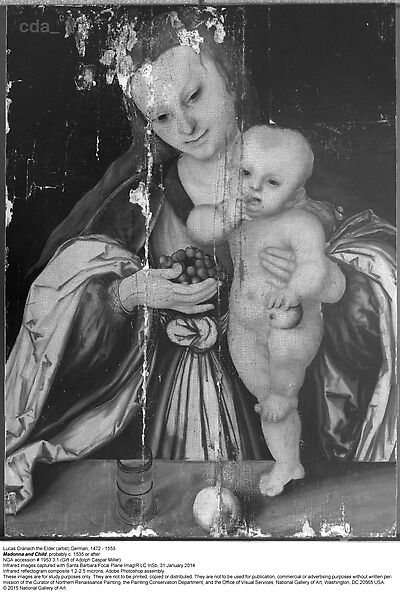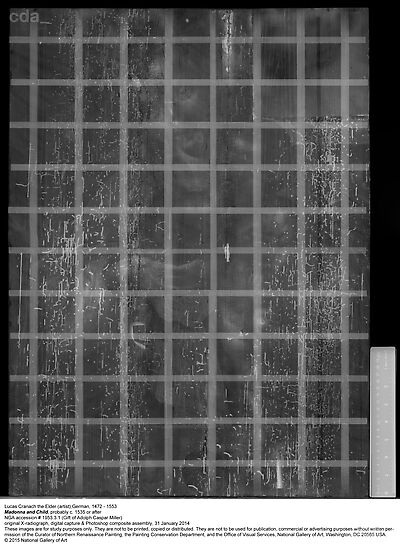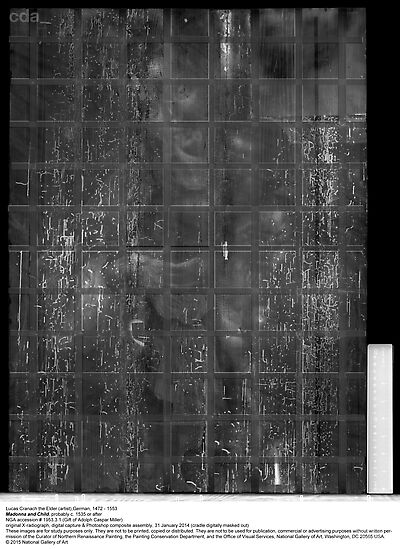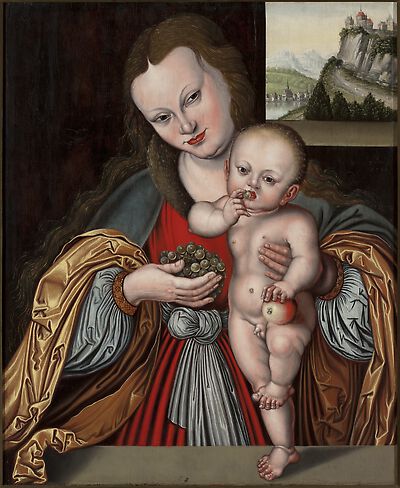'In terms of both style and compositional type, the Washington painting may be associated with a group of pictures depicting the Christ Child standing on the Madonna’s lap and preparing to eat a grape [1]. [...] Another related type includes the infant John the Baptist asleep [2]. Because the Child is shown standing on a parapet and not in the Madonna’s lap, the National Gallery’s picture does not correspond exactly to the other depictions of this theme. A version of the Washington panel that was on the art market in Switzerland in 1972 contains a window looking out on a landscape at the upper right corner [3]. The size of the landscape appears to correspond to the size of the missing top right corner of the National Gallery’s painting and suggests that the background may once have been enlivened by a window and a landscape view. A second replica, also containing a landscape, recently appeared on the market [4].
Interestingly, the ‘Madonna and Child’ was strongly influenced by the early works of Albrecht Dürer. As observed by Talbot, the crinkled, angular drapery folds of the Madonna’s robe and knotted sash are similar to those found in Dürer’s engraving of the ‘Madonna with the Monkey’ from about 1498 [5]. The motif of the standing Child and the placement of the Virgin behind a foreground ledge are found in the Madonnas of Giovanni Bellini, but it is likely that they were transmitted to Cranach through Dürer. For example, Dürer’s ‘The Virgin with the sleeping Child between Saints Anthony and Sebastian’ (Staatliche Kunstsammlungen, Gemäldegalerie, Dresden), painted just after his first trip to Venice, shows the Christ Child on a ledge in the foreground with the Madonna behind. Since Dürer’s painting was commissioned by Friedrich the Wise for the palace church in Wittenberg, it would have been well known to Cranach [6]. Moreover, as probably first noted by Shapley, the pose of the infant Christ, balancing on one leg with the other raised and the foot pressed against the knee, is found in reverse in Dürer’s ‘Madonna and Child’ (National Gallery of Art, Washington, Inv. No. 1952.2.16a), which derives from Bellini and was painted following Dürer’s first trip to Venice [7]. Although the use of such Venetian-inspired devices as the foreground ledge is perhaps more frequent in Cranach’s works from around 1510, they are not unknown in the mature paintings, such as the ‘Virgin and Child with Angels’ of c. 1525 (FR160) [8].'
[1] [Friedländer, Rosenberg 1978, Nos. 388, 389]
[2] [Friedländer, Rosenberg 1978, Nos. 386, 387, 392]
[3] Wood, 85 x 60 cm, sale, Galerie Fischer, Lucerne, 25 November 1972, no. 2355, called Workshop of Lucas Cranach the Elder.
[4] Wood, 79.5 x 56 cm, [Auct. Cat. London 1991, No. 196]
[5] Talbot, draft catalogue entry, 1966, in NGA curatorial files. For Dürer’s engraving [Bartsch, 42] see [Strauss 1972, 42, 43, No. 21, Fig.]
[6] Pointed out by Talbot, draft catalogue entry, 1966, in NGA curatorial files. Following Anzelewsky 1971, 134 -137. Nos. 39, 40 it is now believed that the center portion of the work of a Netherlandish artist but was possibly reworked by Dürer when he added the wings. This does not obviate the strong Venetian flavor of the painting.
[7] Fern Rusk Shapley, discussion, 19 January 1959, in NGA curatorial files.
[8] [Friedländer, Rosenberg 1978, No. 160]. For examples of Cranach’s earlier Madonnas set in front of a landscape and including a bunch of grapes held either by the Child or the Virgin see [Friedländer, Rosenberg 1978, Nos. 29, 30] (PL_DMW_FR029, ES_MTB_114-1936-1).
[Hand, Cat. Washington 1993, 32, 34]






